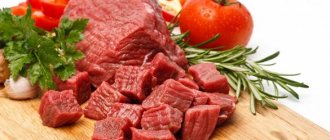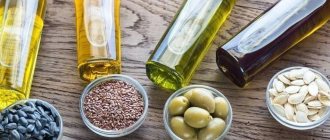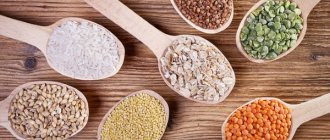© VadimVasenin — depositphotos.com
Share:
Greek nut, Voloshsky, royal acorn, tree of life, food for the brain. The names are different, but we are talking about the walnut, which is familiar to us from childhood. Many attribute almost fantastic properties to this product. K. Tsiolkovsky, for example, believed that nuts could even replace bread in the future.
World walnut production is almost 1 million tons per year. It is included in the menu of astronauts and athletes. However, can this type of nut be considered absolutely safe? In this article, we will objectively examine the properties and qualities of walnuts, explain their value and possible harm to the body, formulate the main contraindications, and also indicate the daily norm.
The most important things about walnuts
Walnut is a long-lived tree. It begins to bear fruit only 12-15 years after planting. And he has been doing this for about 2 centuries. True, after 80 years in slightly smaller volumes.
In Crimea there is a thousand-year-old specimen that still produces 150 thousand nuts annually.
If you have not seen the plant itself in nature, then it will not be difficult to imagine how a nut grows. The principle is similar to the chestnut: first it blooms, then the flower develops into a fruit in a thick green peel. After ripening, the valves of the fruit open and a brown seed in a hard shell falls to the ground. In this form, the nut reaches the consumer. We essentially eat the kernel of the bone.
100 g is 3-4 large nuts. Let's break them down by composition:
- Proteins – 17 g;
- Fats – 63 g;
- Carbohydrates – 12 g;
- Fiber – 6 g.
Vitamin-mineral structure
The vitamin and mineral structure of walnuts is presented in the table:
| Vitamins | |
| A | 9 mcg |
| RR | 5 mcg |
| TO | 3 mcg |
| WITH | 6 mg |
| E | 4 mg |
| IN 1 | 0.4 mg (30% daily value (DV)) |
| AT 2 | 0.2 mg |
| AT 5 | 0.9 mg |
| AT 6 | 0.8 (45% SN) |
| AT 9 | 79 mcg (20% DV) |
| Macro- and microelements | |
| Potassium | 480 mg (28% DV) |
| Magnesium | 125 mg (30% DV) |
| Calcium | 90 mg |
| Sodium | 7 mg |
| Iron | 2 mg |
| Iodine | 3.5 mcg |
| Fluorine | 690 mcg |
| Zinc | 2.6 mg (20% DV) |
| Manganese | 1.9 mcg (90% DV) |
| Phosphorus | 335 mg (45% DV) |
Amino acids
Amino acids (essential):
- Arginine;
- Leucine;
- Methionine;
- Tryptophan;
- Phenylalanine;
- Lysine.
Amino acids (nonessential):
- Glutamic acid;
- Aspartic acid;
- Proline;
- Glycine;
- Tyrosine.
© Ksena-Shu — depositphotos.com. Composition per 50 g of walnuts
Calories and glycemic index
The calorie content of walnuts varies depending on the variety and ranges from 680 to 840 kcal. The glycemic index is low - only 15 units. Gluten free.
Fatty acid
Walnuts contain omega-3, omega-6 and omega-9 fatty acids. 50 g of product covers the daily requirement of these substances for the body. The composition also includes saturated and polyunsaturated fatty acids:
- myristic;
- stearic;
- palmitic;
- linoleic;
- linolenic
Important! In terms of the amount of useful substances, ripe nuts are superior to freshly picked ones.
© AntonMatyukha — depositphotos.com
Daily norm
Although the product is considered dietary and its use can promote weight loss by normalizing metabolism, lowering cholesterol and detoxifying the body, you still cannot eat it in handfuls, because the calorie content of walnuts is quite high.
Nutritionists recommend eating only 30 grams of the product daily, which is equal to 6-8 pieces of nuts for an adult and 4-5 pieces of nuts for children.
If you start regularly eating the fruits of the Greek tree, you will soon notice their positive effect on your body.
Useful properties of walnuts
In 2011, scientist D. Vinson from the University of Scranton (Pennsylvania) spoke at a conference of the American Chemical Society, where he announced the results of a comparative analysis of the beneficial properties of 9 types of nuts. According to the results of the study, the amount of antioxidants that prevent the destruction of human body cells in walnuts is more than 2 times higher than in other types. You can view the results here.
In terms of the ratio of benefits and nutritional value, walnuts are also significantly superior to nuts such as cashews, almonds, and pistachios. In addition, in terms of biological activity and protective properties, walnuts are more than 10 times superior to vitamin E. Let us also note that they contain 50 times more vitamin C than citrus fruits, rose hips and even black currants. Therefore, walnuts can be safely called a universal preventative against any disease.
For metabolism
Athletes value the nut for its ability to speed up metabolism. It also significantly enhances protein production in the body, which has a beneficial effect on muscle mass. The composition of the nuclei helps joints cope with stress and relieves inflammation in them. The optimal amount of potassium (almost 30% of the daily value per 100 g of product) ensures smooth functioning of all muscle groups and has an anticonvulsant effect.
For the cardiovascular system
In tandem with magnesium and alpha-linolenic acid (omega-3), potassium also supports the normal functioning of the cardiovascular system. The risk of heart attacks and strokes due to high blood pressure is reduced. The level of dangerous cholesterol is reduced, the walls of blood vessels are strengthened, and the likelihood of atherosclerosis, which is one of the top four leading causes of death worldwide, is reduced.
Restoration of the body and brain function
After serious illnesses, doctors recommend including walnuts in the menu so that the body recovers faster and anemia does not occur due to iron deficiency. A balanced vitamin composition has an immunomodulatory effect, improves general condition, prevents depression, gives vigor and good mood.
The shape of the walnut kernel resembles a brain. There is a theory that plants that are similar in appearance to human organs bring the greatest benefit to their “doubles”. In the case of walnuts, the hypothesis really works. The nut improves memory, stimulates mental activity, and enhances the interaction of neural connections. Polyunsaturated fatty acids make it possible to seriously delay age-related problems: dementia, Alzheimer's disease.
© xjbxjhxm — depositphotos.com
Among other beneficial properties of walnuts, we highlight the following:
- relieves disturbances in digestive functions, fights dysbacteriosis;
- prevents the development of cancer;
- regulates normal hemoglobin levels, activates hematopoiesis;
- indicated for diabetes, pancreatitis, iodine deficiency, vitamin deficiency;
- due to calcium content, it strengthens bone tissue in adults and children;
- Prevents thyroid diseases.
All these beneficial qualities apply only to raw walnuts. Heat treatment reduces or completely eliminates the positive effect.
Nuts: the most high-calorie varieties and their benefits for weight loss (calorie content table)
Nuts are considered to be the richest source of fats and proteins of plant origin, and therefore many of them are considered excellent meat substitutes.
That is why chefs use the nutritional properties of this product when preparing dishes in any form: whole, chopped, crushed. It is often added to salads, appetizers, pates, and meat dishes. Given these characteristics of the product, it is often included in diets. Let's find out why? This nutritious and valuable product is a unique source of fatty acids, proteins and carbohydrates.
They contain a number of vitamins and microelements, and also contain iodine, which has a beneficial effect on the metabolic process.
In addition, due to their calorie content, nuts replace many prohibited foods.
What are the benefits of nuts for losing weight?
Modern nutritionists advise not to exclude this product from the diet during any diet, because PUFAs help stabilize metabolism, burn extra pounds, and replenish the lack of energy. They should be introduced into the diet wisely:
- You need to eat 8-10 nuts daily. This way you can help the body obtain useful elements and prevent anemia.
- The product can be fried, eaten dried and honey added to it. They complement salads, cereals and other dishes.
Calorie content of various nuts
Nutritionists focus on the ability of nuts to quickly saturate the body without gaining extra pounds. The secret is to increase serotonin, which helps reduce appetite, improve mood and stabilize heart function. All types have this property, but the most high-calorie nuts are:
Almonds – characterized by a high concentration of fibers that improve intestinal function. Tocopherol in its composition is considered a unique antioxidant. Almonds are recommended to be included in low-calorie diets to support immunity and beneficial intestinal bacteria. Walnut is one of the most high-calorie types, which helps protect against damage and prevents early aging. It contains a large amount of antioxidants that prevent inflammation. Cashews are distinguished by the presence of zinc and iron, which fight anemia and protect vision. Thanks to the large amount of magnesium, thinking processes are accelerated and memory loss is prevented. Pistachios – help reduce blood pressure and sugar. They help cleanse the body of accumulated toxins and help heal hair and skin due to the presence of fiber. Hazelnuts – controls sugar levels and prevents the formation of gases in the intestines. The high-calorie nut heals the skin and strengthens the brain. Peanuts – due to their tryptophan content, promotes the production of serotonin. With its help, depression is prevented and mood improves. Hazelnut is the most popular type, restoring organ function and strengthening the immune system. Also, a high-calorie product cleanses the body of toxins. Brazil - among other nuts, this has the lowest calorie content. Their value lies in the content of a huge range of vitamins and elements necessary for the stable functioning of the body.
That is why nutritionists pay special attention to the calorie content of these nuts. They discovered selenium in them, which helps rejuvenate the body and prevents aging.
Just a couple of nuts fills your daily requirement of selenium. In accordance with its calorie content, the product is allowed to be consumed no more than five pieces per day.
Calorie content of nuts (table)
Despite the fact that this is one of the most original products, taking into account its calorie content, you are allowed to eat no more than fifty grams daily. To understand the number of calories in one hundred grams of product, you should familiarize yourself with the table:
| Product | Squirrels | Carbohydrates | Fats | Kcal |
| Coconut | 3 | 28 | 33 | 379 |
| Pistachios | 20 | 7 | 50 | 554 |
| Brazilian nut | 13 | 11 | 65 | 564 |
| Sesame | 19 | 11 | 48 | 564 |
| Peanut | 29,2 | 10 | 50 | 610 |
| Pine nuts | 11 | 19 | 60 | 628 |
| Cashew | 25 | 13 | 53 | 642 |
| Almond | 18 | 15 | 57 | 644 |
| Gretsky | 15 | 10 | 64 | 647 |
| Hazelnut | 16 | 8 | 66 | 703 |
Having examined the data, it can be noted that most protein is present in peanuts, and nuts enriched with vegetable protein saturate the body for a long time. At the same time, the body receives the most microelements and amino acids. Nut protein is the most complex, and therefore it also preserves muscles in normal condition.
For example, pistachios contain few complex carbohydrates, and digestion will take much longer. That is why the body will be full for a long time.
Despite the fact that there is a lot of fat in nuts, you should not be afraid of them. Vegetable fat is not harmful to the body, and even helps vitamins be better absorbed.
Features of eating walnuts
Let's consider the features of using the product for children, men and women.
Children
Children are allowed to try walnuts for the first time at the age of two years. Provided that the child is healthy, does not have a tendency to diathesis and tolerates protein foods well. If you have these problems, then introducing the nut should be postponed for a year.
They usually start with half a kernel and monitor the reaction of the child’s body for 3 days. There is no point in adding other innovations to the menu at the same time. When parents are convinced that there are no rashes, inflammations of the mucous membranes, allergic rhinitis or cough, they can increase the daily intake to several cores. A universal measure is the number of nuts that fit on a child’s palm.
Men
The benefits of walnuts for men were taken into account back in ancient Sparta. Boys and young men were required to eat nut kernels to develop masculinity and maintain strength. This approach makes sense because walnuts contain plant steroids that stimulate testosterone production and support reproductive health in men.
Regular consumption of 50-70 g of nuts is an excellent prevention of prostate adenoma, urological diseases, and improves blood circulation in the pelvic organs. It is acceptable to combine them with figs, prunes and honey. During serious physical activity and high-intensity training, walnuts help to quickly recover and maintain normal energy balance.
Women
The female norm is slightly less - 40 g. However, this amount is enough for women to get the maximum benefit from walnuts. Strong nails, thick hair, smooth skin - this is the effect nuts have on the appearance of the fair half of humanity.
No less important is its effect on well-being:
- relieves painful symptoms of PMS;
- quickly recover from menstrual bleeding;
- prevents breast cancer;
- stabilizes the emotional background.
The vitamin and mineral composition of walnuts is also suitable for expectant mothers. The main thing is to observe the measure - 30 g. Folic acid (B9) and vitamin E help a pregnant woman’s body maintain its own health during pregnancy and prevent serious pathologies in the fetus.
Walnuts relieve the painful feeling of hunger, which often occurs in pregnant women and causes excess weight gain. It is better to eat a couple of nuts between meals than flour or sweets.
Baked goods and sweets provide instant satiation, but it will quickly pass, and the desire to eat will appear again. Nuts cope with this problem. However, in the 2nd and 3rd trimester, daily consumption of nuts is undesirable. It can cause bloating and intestinal problems (increased peristalsis, excess gas formation). During the week, it is better to eat a portion of the royal acorn no more than 3 times.
Benefits for women
Walnut is a source of vitality for the fair half; its use was recommended by Avicenna as a means of restoring the body, a way to overcome disease, preserve beauty, normalize and maintain the overall positive tone of the body. There is benefit in everything, it comes from the tree bark, leaves, shell, partitions, kernel. Vladimir Levi, a famous Russian doctor and psychotherapist, called the nut a holiday of the brain. The benefits of royal nut for women are as follows:
- walnut prevents the development of breast cancer - a modern disease; phytohormones, which contain the kernel, shell and resulting oil, effectively stop mastopathy;
- magnesium resists stress, nervous exhaustion, chronic anxiety, due to constant exposure to which any disease of internal organs can develop;
- preparations based on walnuts have a beneficial effect on the condition of hair and nails, improving the structure and appearance. Regular use of nut-based shampoo and conditioner eliminates dandruff;
- Vitamin A, which walnuts contain, has a regenerating effect. And in combination with other drugs of groups C, E, B, it is very effective in preventing signs of skin aging, rejuvenating it, making it radiant and elastic;
- folic acid successfully fights pathologies of the nervous system;
- iron and vitamin C restore a woman’s body after monthly blood loss and fight anemia;
- flavonoids and antioxidants that walnuts contain increase the body's resistance and restore immunity, especially during the off-season.
Daily consumption of royal nuts will help women improve their health, restore their nervous system, and maintain beauty.
Use of nut
Walnut is a “waste-free” plant. All parts of the tree are used productively: fruits, bark, roots, leaves. The shells are used to make environmentally friendly fuel for boilers, barbecues, and fireplaces - pellets. The foliage and shell are mixed into feed and fertilizers. Powder from nuts and shells is a natural brown dye that is added to oil and other types of paints.
In the production of cosmetics, walnuts are an important ingredient. Its properties are used in medicinal and caring cosmetics to eliminate skin problems; the processed nut and its oil are added to creams, tonics, masks, toothpastes, balms, and lipsticks. The aroma of nut extract is basic for many perfume compositions. Walnut wood is an excellent and sought-after material for furniture production.
Use in cooking
More often, walnuts are associated with delicious desserts: cakes, muffins, pastries, creams, mousses, chocolate products. Oriental sweets (halva, baklava, Turkish delight, nougat) cannot be prepared without nuts. Although in general its gastronomic role is much broader. The piquant taste of meat, poultry, and fish can be easily achieved by adding crushed kernels to the spices.
In salads and main courses, the nut can become an independent ingredient or part of a dressing or sauce. Walnuts are easy to turn into fillings, breadings, and seasonings. Non-alcoholic and alcoholic drinks are made from the kernels. In southern countries, jam is made from unripe fruits and marinades are made for preparations.
© zzayko — depositphotos.com
In medicine and pharmacology
Medical treatises with a centuries-old history tell about the use of walnuts. They indicate the hemostatic effect of the plant, anti-inflammatory, and adsorbent. In the modern pharmaceutical industry, all parts of the walnut tree are used to produce astringents, bactericidal, tonic and antiparasitic agents. Walnut is included in the pharmacopoeias of different countries - a strictly established standard of rules for the production and testing of medicines.
There are herbal preparations with walnut extract for anti-tuberculosis therapy. Walnut kernel oil is used to treat and restore skin after burns. Russian pharmacologists have patented an ointment that contains an extract of green nut fruits with pericarp and tree leaves. It is intended for the treatment of mastopathy.
Traditional medicine is replete with recipes based on walnuts made from peels, kernels, partitions, and shells. Alcohol tinctures and decoctions, according to the “healers,” are supposed to cure all diseases. Please note that such recommendations are unproven and subjective, and the consequences of such treatment are unpredictable.
Properties of nuts for weight loss
70% of walnuts consist of fats, which, it would seem, automatically makes the product far from dietary. And it has enough calories. How then can we explain that walnuts have been an integral part of the ascetic diet of yogis for hundreds of years? The answer lies in one of the latest experiments by researchers from San Diego. Almost 300 women from 25 to 72 years old took part in it. You can view the experiment here.
All ladies received clear nutritional instructions: reduce the total caloric intake of the diet by 500-700 kcal and the amount of carbohydrates in it. Group No. 1 lost weight by eating walnuts (40 g per day), group No. 2 did not include them in the menu. As a result, the “nut” group lost 10% of weight, the other only 5%. The organizers made conclusions. Participants in the first group ate less overall because they felt fuller longer after eating a small portion of nuts. That's the whole secret of losing weight. In addition, vegetable protein was easily digestible, and fiber stimulated the gastrointestinal tract.
Advice. Don't like porridge without butter, but are on a diet? Replace the oil with a couple of walnut kernels. This dish will delight you with taste and will be much healthier.
© 5PH — depositphotos.com
Benefits of almond oil
This product is considered one of the most powerful bactericides. It has a pronounced antiseptic property that eliminates irritation and disinfects wounds.
The oil softens the skin, stimulates blood flow and healing. Thanks to this same effect, it is also used in medicine as a coating for the stomach, reducing acidity, facilitating the digestive process. It also works as a laxative.
Almonds are often processed in cosmetology. It accelerates hair growth and nourishes hair follicles, which is why this component is often found in shampoos and gels for eyelashes and eyebrows. In addition to growth, the nut gives hair a natural shine and strong structure.
The oil does not cause skin irritation, so dermatologists advise using it even in the care of infants. It nourishes the skin, evens out the tone of the face, moisturizes the skin even in delicate areas: décolleté, bikini, eyelids.
Bitter almond oil is highly valued in aromatherapy. It improves concentration, helps to recover from shock and depression, returns consciousness, and activates brain activity.
Harm and possible contraindications
All beneficial properties lose their relevance if a person has an intolerance or allergy to walnuts. Moreover, these concepts should not be confused. Intolerance means that the body does not have a special enzyme to digest the protein contained in the nut. As a result, problems with the gastrointestinal tract arise. The symptoms are essentially similar to food poisoning: vomiting, diarrhea, discomfort.
With allergies, the situation is much more serious. The immune system perceives the nut not as food, but as a toxic substance and begins to fight it. This manifests itself in the form of a rash, dermatitis, numbness of the tongue, fainting, decreased blood pressure and even anaphylactic shock with a fatal outcome. Therefore, it is dangerous for allergy sufferers not only to eat a tiny portion of walnuts, but also to eat foods with traces of the product. This could be candy or any confectionery product that, for example, was packaged using a conveyor where nuts were previously processed or packaged.
Any cosmetics and medicines containing an extract from any part of the plant are also dangerous. There have been cases when angioedema occurred in a patient after a banal kiss with a partner who had eaten a walnut. In a child with an allergy, an attack can also be caused by short-term contact with a nut peel (crafts in the garden, at school made from shells; a fruit accidentally found under a tree).
Important! Most types of nuts are strong allergens. If you are allergic to walnuts, give your children special tests before giving them any form of walnut.
However, if a child has an allergic reaction only to walnuts, then there is a high probability that by the age of 12 it will disappear. A mature immune system will perceive the product normally. But when there is an allergy to several types of nuts, then, most likely, the nut protein will continue to be rejected by the body.
The nut should be consumed with caution and the daily intake should be reduced if:
- increased blood clotting and thrombosis;
- intestinal diseases (colitis, Crohn's disease, irritable bowel syndrome)*;
- obesity types 2 and 3;
- psoriasis, eczema, neurodermatitis - the nut provokes a new surge in diseases.
*During an exacerbation, it is better to completely exclude it from the diet.
Spoiled, darkened, old walnuts pose a great danger. They are susceptible to damage by a specific type of mold. The peculiarity of microscopic fungi is that they destroy the liver and can even stimulate the growth of cancer cells. Mold does not lose its toxic and carcinogenic properties even when heated.
Recipes for healthy eating
Halibut in a frying pan
- 13.1 g Protein
- 12.9 g Fat
- 8.6 g Carbohydrates
- 200.5 kcal
25-30 min.
- #avocado
- #second course
- #lemon
- #flour
- #dinner
- #roasting
- #olive oil
- #tomato
- #vegetable oil
- #fish
- #spices
- #dinner
Other recipes
Varieties
There are four main varieties of walnut (Japanese, English, black and white). The Japanese species grows very quickly, the size of the tree is quite compact (about 8 meters in height), and the fruits have a sweet taste. English nuts are distinguished by their small fruit size and thin shell.
Black walnuts, on the other hand, have a thick shell. It is not easy to crack, but the kernel of such a nut has a pleasant, pungent aroma. The white walnut species is today on the verge of extinction. This type is quite rare. Its fruits are oily and sweet in taste. In Russia, several varieties of walnuts have currently been developed, adapted to difficult climatic conditions. These are:
- Abundant (trees about 3 meters high and a yield of about 30 kg, average fruit weight - 11 grams)
- Elegant (a variety with high drought resistance and resistance to pests, trees bear fruit weighing 20-22 kg, the nuts themselves have a sweetish taste)
- Aurora (frost-resistant variety with a tree yield of about 25 kg, average fruit weight - 12 grams)
- Fruitful (winter-hardy variety, tree yield is about 27 kg, fruits weighing 9 grams, suitable for cultivation in all regions)
- Ideal (the difference between this variety is that the trees have a very high yield, reaching 100 kg, which makes the variety very popular).











